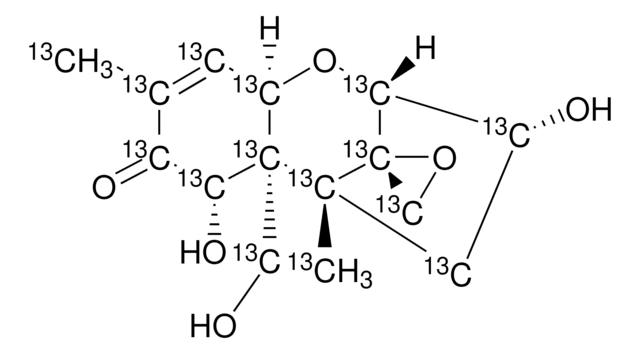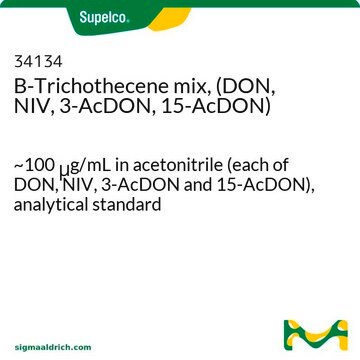34124
Deoxynivalenol solution
100 μg/mL in acetonitrile, analytical standard
Synonym(s):
3α,7α,15-Trihydroxy-12,13-epoxytrichothec-9-en-8-one, DON, Vomitoxin
About This Item
Recommended Products
grade
analytical standard
shelf life
limited shelf life, expiry date on the label
concentration
100 μg/mL in acetonitrile
technique(s)
HPLC: suitable
gas chromatography (GC): suitable
application(s)
cleaning products
cosmetics
food and beverages
personal care
format
single component solution
storage temp.
−20°C
SMILES string
CC1=C[C@H]2O[C@@H]3[C@H](O)C[C@@](C)([C@]34CO4)[C@@]2(CO)[C@H](O)C1=O
InChI
1S/C15H20O6/c1-7-3-9-14(5-16,11(19)10(7)18)13(2)4-8(17)12(21-9)15(13)6-20-15/h3,8-9,11-12,16-17,19H,4-6H2,1-2H3/t8-,9-,11-,12-,13-,14-,15+/m1/s1
InChI key
LINOMUASTDIRTM-QGRHZQQGSA-N
Looking for similar products? Visit Product Comparison Guide
Related Categories
General description
Check out our entire range of trichothecene type mycotoxin reference materials
Application
Signal Word
Danger
Hazard Statements
Precautionary Statements
Hazard Classifications
Acute Tox. 4 Dermal - Acute Tox. 4 Inhalation - Acute Tox. 4 Oral - Eye Irrit. 2 - Flam. Liq. 2
Storage Class Code
3 - Flammable liquids
WGK
WGK 2
Flash Point(F)
35.6 °F - closed cup
Flash Point(C)
2 °C - closed cup
Personal Protective Equipment
Choose from one of the most recent versions:
Already Own This Product?
Find documentation for the products that you have recently purchased in the Document Library.
Customers Also Viewed
Related Content
Detailed list of mycotoxin analysis products for Food & Beverage manufacturers and testers, ensuring safety standards.
Detailed list of mycotoxin analysis products for Food & Beverage manufacturers and testers, ensuring safety standards.
Detailed list of mycotoxin analysis products for Food & Beverage manufacturers and testers, ensuring safety standards.
Detailed list of mycotoxin analysis products for Food & Beverage manufacturers and testers, ensuring safety standards.
Our team of scientists has experience in all areas of research including Life Science, Material Science, Chemical Synthesis, Chromatography, Analytical and many others.
Contact Technical Service










